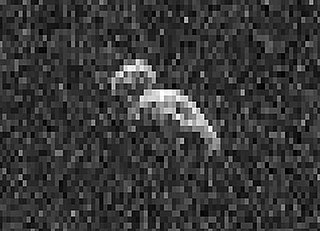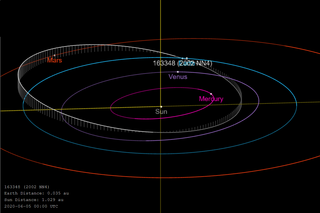Related Research Articles
(68950) 2002 QF15 is a stony asteroid, classified as near-Earth object and potentially hazardous asteroid of the Apollo group, that measures approximately 2 kilometers in diameter. It was discovered on 27 August 2002, by the LINEAR project at Lincoln Laboratory's Experimental Test Site in Socorro, New Mexico, United States.
8034 Akka, provisional designation 1992 LR, is a sub-kilometer sized, eccentric asteroid and near-Earth object of the Apollo group, approximately 540 meters in diameter. It was discovered at Palomar Observatory in 1992, and named after Akka from Finnish mythology.
(467336) 2002 LT38, is a sub-kilometer asteroid and suspected tumbler, classified as a near-Earth object and potentially hazardous asteroid of the Aten group, approximately 240 meters (790 ft) in diameter. It was discovered on 12 June 2002, by astronomers of the Lincoln Near-Earth Asteroid Research at the Lincoln Laboratory's Experimental Test Site near Socorro, New Mexico, in the United States.

(7482) 1994 PC1 is a stony asteroid, classified as near-Earth object and potentially hazardous asteroid of the Apollo group, approximately 1.1 kilometers in diameter. It was discovered on 9 August 1994, by astronomer Robert McNaught at the Siding Spring Observatory in Coonabarabran, Australia. With an observation arc of 47 years it has a very well known orbit and was observed by Goldstone radar in January 1997. The 2022 approach has been observed every month since August 2021.
(416151) 2002 RQ25 is a carbonaceous asteroid of the Apollo group, classified as near-Earth object and potentially hazardous asteroid, approximately 0.2 kilometers in diameter. It was discovered on 3 September 2002, by the Campo Imperatore Near-Earth Object Survey (CINEOS) at the Italian Campo Imperatore Observatory, located in the Abruzzo region, east of Rome.
(242450) 2004 QY2 (prov. designation:2004 QY2) is an asteroid on an eccentric orbit, classified as near-Earth object and potentially hazardous asteroid of the Apollo group, approximately 3 kilometers (2 miles) in diameter. It was discovered on 20 August 2004 by the Siding Spring Survey at an apparent magnitude of 16.5 using the 0.5-metre (20 in) Uppsala Southern Schmidt Telescope. It is one of the largest potentially hazardous asteroids known to exist.

(388188) 2006 DP14, provisional designation 2006 DP14, is a sub-kilometer sized, peanut-shaped asteroid on a highly eccentric orbit, classified as near-Earth object and potentially hazardous asteroid of the Apollo group. This contact binary was discovered on 23 February 2006, by astronomers of the LINEAR program at the Lincoln Laboratory's Experimental Test Site near Socorro, New Mexico, in the United States. On 10 February 2014, it passed 6.25 lunar distances from Earth. The asteroid is approximately 400 meters in diameter and has a rotation period of 5.77 hours.
(391211) 2006 HZ51 is a bright, sub-kilometer asteroid on an eccentric orbit, classified as a near-Earth object and a potentially hazardous asteroid of the Amor group. It was discovered on 27 April 2006, by astronomers of the Catalina Sky Survey conducted at Mount Lemmon Observatory, Arizona, United States. During preliminary observations, it was thought to have a small chance of impacting Earth in 2008. The asteroid measures approximately half a kilometer in diameter and has an exceptionally high albedo.
(456938) 2007 YV56, provisional designation 2007 YV56, is a sub-kilometer asteroid on an eccentric orbit, classified as a near-Earth object and potentially hazardous asteroid of the Apollo group, approximately 190–360 meters (620–1,200 ft) in diameter. It was discovered on 31 December 2007, by astronomers of the Catalina Sky Survey conducted at the Catalina Station in Arizona, United States.
2001 AV43 is a very small, monolithic asteroid and fast rotator, classified as a near-Earth object of the Apollo group, approximately 30 meters (98 feet) in diameter. It was first observed on 5 January 2001, by astronomers of the LINEAR program at Lincoln Laboratory's Experimental Test Site near Socorro, New Mexico, in the United States. The presumed S-type asteroid has a rotation period of only 10 minutes. It has an exceptionally low MOID of 0.66 lunar distance (LD) and will approach Earth at 0.81 LD on 11 November 2029.

(190166) 2005 UP156 is a stony asteroid and binary system, classified as near-Earth object of the Apollo group, approximately 1 kilometer in diameter. It was discovered on 31 October 2005, by astronomers of the Spacewatch survey at the Kitt Peak National Observatory in Arizona, United States. Its minor-planet moon with an orbital period of 40.25 hours was discovered in 2017.
(90075) 2002 VU94, provisional designation 2002 VU94, is an asteroid on an eccentric orbit, classified as near-Earth object and potentially hazardous asteroid of the Apollo group, approximately 2.5 kilometers in diameter. It was discovered on 13 November 2002, by astronomers of the Near-Earth Asteroid Tracking program at Palomar Observatory in California, United States. It is one of the largest potentially hazardous asteroids known.
(159857) 2004 LJ1, provisional designation 2004 LJ1, is an asteroid on an eccentric orbit, classified as near-Earth object and potentially hazardous asteroid of the Apollo group, approximately 3 kilometers in diameter. The asteroid was discovered on 10 June 2004, by astronomers of the LINEAR program at Lincoln Laboratory's Experimental Test Site near Socorro, New Mexico, in the United States. It is one of the largest potentially hazardous asteroids known to exist.
2013 GM3 is a micro-asteroid, classified as near-Earth object of the Aten group, approximately 20 meters in diameter. It was first observed on 3 April 2013, by astronomers of the Mount Lemmon Survey conducted at the Mount Lemmon Observatory near Tucson, Arizona, United States.

(505657) 2014 SR339, provisional designation 2014 SR339, is a dark and elongated asteroid, classified as near-Earth object and potentially hazardous asteroid of the Apollo group, approximately 970 meters (3,200 feet) in diameter. It was discovered on 30 September 2014, by NASA's Wide-field Infrared Survey Explorer telescope (WISE) in Earth's orbit. Closely observed at Goldstone and Arecibo in February 2018, it has a rotation period of 8.7 hours.
(143651) 2003 QO104, provisional designation 2003 QO104, is a stony asteroid, slow rotator and suspected tumbler on a highly eccentric orbit, classified as near-Earth object and potentially hazardous asteroid of the Amor and Apollo group, respectively. It was discovered on 31 August 2003, by astronomers of the Near-Earth Asteroid Tracking program at the Haleakala Observatory in Hawaii, United States. The Q-type asteroid has a rotation period of 114.4 hours and possibly an elongated shape. It measures approximately 2.3 kilometers (1.4 miles) in diameter and belongs the largest potentially hazardous asteroids known to exist.
(163243) 2002 FB3, provisional designation 2002 FB3, is a stony asteroid on an eccentric orbit, classified as near-Earth object and potentially hazardous asteroid of the Athen group, approximately 1.6 kilometers (1 mile) in diameter. It was discovered on 18 March 2002, by astronomers with the Lincoln Near-Earth Asteroid Research at the Lincoln Laboratory's Experimental Test Site near Socorro, New Mexico, in the United States. The Q-type asteroid has a rotation period of 6.2 hours.
(85182) 1991 AQ, provisional designation 1991 AQ, is a stony asteroid on a highly eccentric orbit, classified as near-Earth object and potentially hazardous asteroid of the Apollo group, approximately 1.1 kilometers in diameter. It was discovered on 14 January 1991, by American astronomer Eleanor Helin at the Palomar Observatory in California. Based on its brightness variation of 0.69 magnitude, this Q-type asteroid is likely elongated. It belongs to the small group of potentially hazardous asteroids larger than one kilometer.
(385343) 2002 LV, provisional designation 2002 LV, is a stony asteroid on a highly eccentric orbit, classified as near-Earth object and potentially hazardous asteroid of the Apollo group, approximately 1.5 kilometers in diameter. It was discovered on 1 June 2002, by astronomers with the Lincoln Near-Earth Asteroid Research at the Lincoln Laboratory's Experimental Test Site near Socorro, New Mexico, in the United States. The Sr-type asteroid has a rotation period of 6.2 hours and is likely elongated.

(163348) 2002 NN4 (prov. designation:2002 NN4) is a dark, sub-kilometer near-Earth object and potentially hazardous asteroid of the Aten group that flew by Earth on 6 June 2020. The highly elongated X-type asteroid has a rotation period of 14.5 hours and measures approximately 0.7 kilometers (0.4 miles) in diameter. It was discovered by LINEAR at the Lincoln Laboratory's Experimental Test Site in New Mexico on 9 July 2002.
References
- 1 2 3 4 5 6 "154276 (2002 SY50)". Minor Planet Center. Retrieved 20 April 2018.
- 1 2 3 4 5 6 7 "JPL Small-Body Database Browser: 154276 (2002 SY50)" (2014-06-07 last obs.). Jet Propulsion Laboratory . Retrieved 20 April 2018.
- 1 2 3 4 5 6 "LCDB Data for (154276)". Asteroid Lightcurve Database (LCDB). Retrieved 20 April 2018.
- 1 2 3 4 Nugent, C. R.; Mainzer, A.; Masiero, J.; Bauer, J.; Cutri, R. M.; Grav, T.; et al. (December 2015). "NEOWISE Reactivation Mission Year One: Preliminary Asteroid Diameters and Albedos". The Astrophysical Journal. 814 (2): 13. arXiv: 1509.02522 . Bibcode:2015ApJ...814..117N. doi:10.1088/0004-637X/814/2/117. S2CID 9341381.
- 1 2 3 Carry, B.; Solano, E.; Eggl, S.; DeMeo, F. E. (April 2016). "Spectral properties of near-Earth and Mars-crossing asteroids using Sloan photometry". Icarus. 268: 340–354. arXiv: 1601.02087 . Bibcode:2016Icar..268..340C. doi:10.1016/j.icarus.2015.12.047. S2CID 119258489.
- 1 2 "Close-Approach Data, JPL Small-Body Database Browser: 154276 (2002 SY50)". Jet Propulsion Laboratory. Retrieved 20 April 2018.
- ↑ Nesvorný, D.; Broz, M.; Carruba, V. (December 2014). "Identification and Dynamical Properties of Asteroid Families". Asteroids IV. pp. 297–321. arXiv: 1502.01628 . Bibcode:2015aste.book..297N. doi:10.2458/azu_uapress_9780816532131-ch016. ISBN 9780816532131. S2CID 119280014.
- ↑ "MPC/MPO/MPS Archive". Minor Planet Center. Retrieved 20 April 2018.